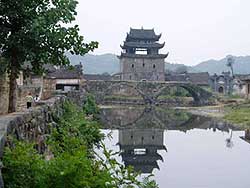 The 16-metre-tall wooden building Wenchangge (House of the Learned) is a landmark at the entrance of Shanggantang Village in Central China's Hunan Province.
The 16-metre-tall wooden building Wenchangge (House of the Learned) is a landmark at the entrance of Shanggantang Village in Central China's Hunan Province.
Their ancestors, the Zhou family, allegedly travelled about 1,000 kilometres from Qingzhou in East China's Shandong Province to Hunan in the 9th century to avoid wars, and settled down in a small basin in the Gantang Mountain in 827 AD.
Only seven households are not members of the original family, according to a 1,200-year-old family tree. The villagers have pledged to protect their traditions in today's overwhelming tide of globalization and modernization.
So far they have preserved the buildings and lay-out of the village, which is surrounded by a small river. A mountain path leads to a 16-metre-tall wooden building called Wenchangge (House of the Learned), a landmark at the entrance of the village.
The four-storey building has had five facelifts since it was completed at the end of the Ming Dynasty (1368-1644). To its east are four brick houses in the Ming style, with coloured paintings on parts of walls under upturned eaves.
They are the remains of an ancient school, Lianxi Shuyuan (Lianxi Academy). Other houses at the village entrance, all of which are more than 300 years old, are the remains of a Buddhist temple and a Buddhist nunnery, where villagers used to worship the ancestors of the Zhou family as well as the Buddha.
Small opera troupes that tour the area still perform on a 300-year-old stage, and a pavilion of roughly the same age shelters passers-by and villagers working in the fields nearby. Villagers say that for a millennium, people have been gathering at the patch of land at the village entrance on important occasions such as festival celebrations and ceremonies that are held to pay sacrifices to their common ancestors.
Part of an ancient stone post road runs beside the House of the Learned. Before the 20th century, the village was an important hub on the road from Hunan to Southwest China's Guangxi Zhuang Autonomous Region, said sources with the Hunan Cultural Heritage Administration.
A walk north from the House of the Learned along the post road leads to a bridge over the river around the village. The bridge is called Buying (walk into a fairy island). Built in AD 1126, the stone bridge, 30 metres long and 4.5 metres wide, had four major renovations in 1135, 1278, 1468 and during the reign of the Emperor Qianlong (reign 1736-1796) of the Qing Dynasty (1644-1911), says the book of the family tree, which also records the history of the village.
The bridge has been badly damaged by flooding, revealing its structure of square rocks. It is also known as Duxian, or Immortal Crossing. Legend has it that when the bridge was completed, the villagers held a ceremony, attended by the immortal Tieguai Li, or Li the Iron Stick. As he stepped onto the bridge, half of it gave way beneath his iron stick.
Today, villagers still like to tell the story to anyone interested. Villager Zhou Jiusheng said: "The villagers weren't happy. But Li the Iron Stick laughed. He said it was the will of Heaven. Every rock that had fallen from the bridge represented a top official from the village."
As you walk across the bridge, you feel like you are stepping 800 years back into history. Altogether, 101 rocks fell from the bridge, and this is the number of officials above the rank of magistrate that have hailed from the village.
Today's inhabitants of Shanggantang are the 48th generation of Zhous. Despite many changes of dynasty and constant warfare, the family has managed to maintain its lineage in the same village.
The locals keep a "Portrait of 100 Officials," which includes 18 who served in the national capital and 11 scholars who won the title Jinshi, or the successful candidates in the highest imperial examinations for officialdom.
For almost a century, one small rock in the bridge has seemed to be on the point of coming away. The villagers hope it will fall soon, because it will mean another great official will appear.
Across the river lies a village filled with houses built during the Ming and Qing dynasties. This is a village typical of the ancient villages of the Yangtze River reaches in Central China, where there is limited land for farming and even less for buildings. It has more than 200 brick houses regularly arranged in a compact community.
All the houses have two or three storeys. Their upturned eaves are decorated with earthenware sculptures and their white walls with carved wooden windows. At the southwestern corner of the village there is a mountain slope on which the Zhou family has carved its history.
The 24 carvings on barren stones along the slope are all writings that record important events in the history of the family. Of them two were made in the Northern Song Dynasty (960-1127), four in the Southern Song Dynasty (1127-1279), one in the Yuan (1271-1368), 11 in the Ming and others in the Qing.
The most spectacular is a carving of four giant characters, 1.5 metres long and 1 metre wide each, written by Wen Tianxiang (1236-1282). Known for his literary achievements, Wen is primarily remembered as a hero and loyalist.
The Prime Minister of the Southern Song regime led a losing war defending the regime against the invading Mongols and died as a martyr years later in captivity. Historical documents of the village said Wen sent one message with the four characters "zhong xiao lian jie" (loyalty, filial obedience, honesty, moral courage), to a member of the Zhou family named Deyuan, who was also a government official of the Southern Song regime.
The Zhou family hid the piece after the fall of the Southern Song Dynasty and kept it as their motto. About four centuries after the fall of the Mongolian empire in 1368, they had the four characters carved on the stone to be remembered forever. The village is the only one known in Hunan Province that has in the past millennium had its history recorded in such a complete, detailed way and carved on a mountain slope, said sources with the provincial cultural heritage administration.
Buddhist Travel
Traveler Tales
Shanggantang where time lingers on
By Tang Hongyi, China Daily. Dec 14, 2004
Shanggantang, Hunan (China) -- A 1,200-year-old village lies complete in the mountains of Central China. Shanggantang Village, 25 kilometres south of Jiangyong Town, Hunan Province, is home to 433 households, 1,865 people, almost all of whom belong to one ancestral family.



